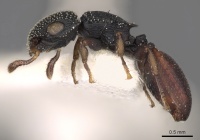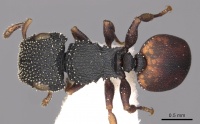Cataulacus pompom
| Cataulacus pompom | |
|---|---|

| |
| Scientific classification | |
| Kingdom: | Animalia |
| Phylum: | Arthropoda |
| Class: | Insecta |
| Order: | Hymenoptera |
| Family: | Formicidae |
| Subfamily: | Myrmicinae |
| Tribe: | Crematogastrini |
| Genus: | Cataulacus |
| Species: | C. pompom |
| Binomial name | |
| Cataulacus pompom Snelling, R.R., 1979 | |
Nothing is known about the biology of Cataulacus pompom.
Identification
Cephalic and mesosomal sculpturation reduced; cephalic dorsum with abundant very short bizarre hairs. A member of the taprobanae group as evidenced by the reduced sculpturation, with the rugulae of the mesosomal dorsum principally longitudinal. The occipital crest is normal for the group, and is especially similar to that of such species as Cataulacus praetextus and Cataulacus reticulatus. It is immediately different from all taprobanae group species in the abundance of bizarre hairs on the cephalic and mesosomal dorsa. Hairs of this type appear to be of rare occurrence in the Indo-Australian-Oriental fauna although frequent in species of the Ethiopian Region. Somewhat similar, though less bizarre, hairs are seen in Cataulacus simoni and, to a lesser degree, Cataulacus granulatus. These are members of the granulatus group and differ from pompom in the nature of the cephalic and mesosomal sculpture. (Snelling 1979)
Distribution
Distribution based on Regional Taxon Lists
Indo-Australian Region: Malaysia (type locality).
Distribution based on AntMaps
Distribution based on AntWeb specimens
Check data from AntWeb
Countries Occupied
| Number of countries occupied by this species based on AntWiki Regional Taxon Lists. In general, fewer countries occupied indicates a narrower range, while more countries indicates a more widespread species. |

|
Estimated Abundance
| Relative abundance based on number of AntMaps records per species (this species within the purple bar). Fewer records (to the left) indicates a less abundant/encountered species while more records (to the right) indicates more abundant/encountered species. |

|
Biology
|
Castes
Nomenclature
The following information is derived from Barry Bolton's Online Catalogue of the Ants of the World.
- pompom. Cataulacus pompom Snelling, R.R. 1979a: 8, figs. 19-26 (w.) WEST MALAYSIA.
- Type-material: holotype worker, 9 paratype workers.
- Type-locality: holotype Malaysia (“Malaya”): Selangor, Gombak, 2.x.1973 (B. Bolton); paratypes with same data.
- Type-depositories: BMNH (holotype); BMNH, LACM (paratypes).
- Status as species: Bolton, 1995b: 139.
- Distribution: Malaysia (Peninsula).
Unless otherwise noted the text for the remainder of this section is reported from the publication that includes the original description.
Description
Worker
Holotype worker. TL 3.46; HL 0.83; HW 0.94; CI 112; EL 0.32; OI 34; IOD 0.72; SL 0.45; SI 48; PW 0.69; WL 0.96; MTL 0.37.
Occipital crest complete, the median portion raised into a low, projecting ridge in full-face view; with well-separated weak denticles. Side of head denticulate behind eyes, occipital corner with a low, broad, triangular tooth. Sides of propodeum with a narrow, rectangular expansion, marked at each end by a blunt denticle and with another, smaller, denticle near middle. Sides of mesonotum roughly triangular in dorsal view, with a deep V-shaped notch separating them from propodeum. Propodeum behind this notch with a short free anterior face; side marginate, continuous with side of spine, margin with two or three minute denticles. First gastric tergum marginate on anterior one-fourth, margin with several weak, oblique denticles.
Dorsal surface of head finely rugoreticulate, interspaces finely and densely reticulate-punctate. Dorsal surface of mesosoma similar, but with longitudinal rugulae stronger. Dorsal surfaces of petiole and postpetiole very densely reticulate-punctate, with a few short, obscure longitudinal rugulae. First gastric tergum finely and very densely reticulate-punctate, with numerous short, fine obscure rugulae, the majority of which are more or less longitudinal.
Dorsal surface of head with numerous very short, bizarre hairs (Fig. 24), but with a few longer, subspatulate hairs along inner eye margin. Dorsal surface of mesosoma with short, bizarre hairs along margins and with two transversely arcuate rows across anterior part of pronotum. Petiole and postpetiole each with a few similar hairs; first gastric tergum with a short, bizarre hair on each marginal denticle. Dorsal surfaces of meso- and metafemora and external surface of mesotibia with 1-4 such hairs.
Paratype workers. TL 2.87-3.44; HL 0.74-0.85; HW 0.83-0.94; CI 110-114; EL 0.28-0.32; OI 33-35; IOD 0.65-0.71; SL 0.40-0.44; SI 47-49; PW 0.60-0.69; WL 0.81-0.97; MTL 0.33-0.40 (9 measured).
Type Material
Holotype worker, MALAYA: Selangor, Gombak, 2 Oct. 1973 (B. Bolton), from topmost twigs of felled forest tree, in British Museum (Natural History). Paratype workers, 9, same data as holotype, in British Museum (Natural History) and Los Angeles County Museum of Natural History.
Etymology
The name proposed for this species is an arbitrary combination of letters and should be treated as a noun.
References
- Snelling, R. R. 1979a. Three new species of the Palaeotropical arboreal ant genus Cataulacus (Hymenoptera: Formicidae). Contr. Sci. (Los Angel.) 315: 1-8 (page 8, figs. 19-26 worker described)
References based on Global Ant Biodiversity Informatics
- Snelling R. R. 1979. Three new species of the Palaeotropical arboreal ant genus Cataulacus (Hymenoptera: Formicidae). Contributions in Science (Los Angeles) 315: 1-8.

